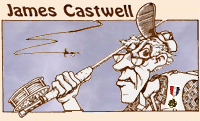|
Advanced casting is the result of practice. Those who
won't practice won't ever get there. One of the worst
places to practice, or think you are practicing casting
is while fishing. Either you should practice casting or
go fishing. Not both at the same time. I know, it seems
like you should be able to, but if you are working on your
casting, you sure aren't giving fishing a fair shot. Your
casting should be automatic when you are fishing. The fish
deserve at least that much. It is an insult for them to be
caught by a sloppy caster and they feel very sensitive
about these things. Being the upstanding guy you are I
am sure you wouldn't insult any fish, trout or pan.
So, now that you have decided to uphold your obligations
and actually learn how to cast good, what exactly is it
you should practice at? Right. You don't have a clue. Good,
Honesty is Always the Best Policy. Your casting leaves lots
of room for improvement and mostly you hope whomever is
watching you never saw 'The Movie!' Now we're getting
somewhere. Start here.
At least this year, clean the fly line. Please. It really
will help it go through the little thingies on your rod
and even help it float (especially if it is a 'floater').
Is there any possibility you can fine a place to practice
where your line won't get damaged? A lawn would be nice,
a pond or lake or even a river if it is not ripping along
at five knots. Actually, those of us top professional
expert caster guys have a special line we use for practice
(when we do it). No big deal, it's an old line that served
it's time on the stream and we replaced it with a dandy
new one.
Line control is where it's at. Too many think casting is
about the rod. It's about the line. Where it's supposed
to go and how to get it there. The rod is only a stick
that helps you cast the line. Remember that... cast the
line. Let's get started. I am going to presume you are
not just reading this and I didn't take my valuable time
writing this whole page of wisdom just so you could be
entertained. You are going to practice. If you don't you
should feel guilty. Don't worry, I will remind you of it
when we meet someday. You can show me then how much you
have learned. Ok?
Step one. Line cleaned, rod strung, at least nine feet of
something resembling a leader (just mono will work most of
the time) room to swing the thing, no one looking,
especially any close relative or acquaintance. Swing the
rod tip around in a big circle like a cowboy with a lariat.
This will clear a space for the rest of the practice and
convince anyone watching to leave as you certainly have
no idea of what you are doing. No one wants to spend time
watching an idiot, they can learn nothing. Now that you
are truly alone, flip out about twenty or twenty-five feet
of line in front of you and just let it lay one the ground
(or whatever it is on). With the tip of the rod make little
circles while sweeping the rod from in front of you off to
your right side. This will cause little hoops or coils of
line to form and run on the ground (water, or whatever) as
you sweep the rod along.
This will not be of any real value but, I just want to see
if you can follow directions. They are kinda of cute and
you can impress others with this someday when you actually
learn how to cast better. It may help to graphically
demonstrate however that the line goes where ever the tip
of the rod does. I suppose that could be of some value
after all, who knows.
After you have entertained yourself with your newfound skill
try to get more serious and lets start learning something that
may make our casting even better. Loops. Big ones, medium ones
and little ones; on command. You're in control though, but that
is the next thing for you to try. I know you can cast some,
but you are here to become an advanced caster guy, right? So
let's advance. Make a big loop with the fly line in the air.
Big loop. How do you do that? By swinging the rod more and
not stopping it as much as you are supposed to.
Now make the loops out in front of you gradually tighter,
smaller narrower. Just a little at a time. You will find
that the more you use the tip of the rod and stop the rod
the tighter they will become. In fact, if you stop the rod
sharply enough you can actually make the line twist around
itself on the way forward. That is also called a tailing loop.
It is good to know how to make one so you can understand how
not to make one. Sometime when you may be fishing and are
trying really hard to make a cast and find that the harder
you try the worse it gets (more tailing loops) you will
understand not only what went wrong but how to fix them.
Now that you have mastered the big and small loops in your
forward casts do the same thing in your back casts. I know,
it's not all that easy, but I have confidence in you. You
can do this. Get with it. These are just a couple of the
things you need to be on the road to becoming a competent
caster. Who knows, some day even an advanced caster. There
is always the underhanded flip-thru-the-loop reverse delivery
high-hopping presentation cast I am so famous for. Now,
that is advanced. ~ JC
|



